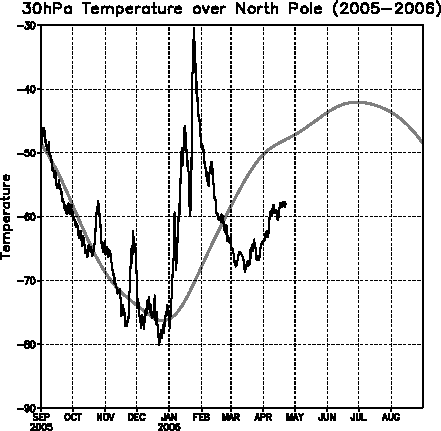 |
Abstract
An unusual stratospheric major warming occurred in the end of January 2006. In the event, developed ridge over central Siberia was remarkable at 30 hPa with rapid warming and temperature over the North Pole reached to 40 °C higher than its normal. It was shown by this analysis that vertical and horizontal energy propagation of planetary-scale waves from the troposphere to the stratosphere played an important role in the major warming.
1. Introduction
An unusual stratospheric sudden warming occurred in January 2006. Figure 1 shows time sequence of 30 hPa temperature over the North Pole. The warming started in the beginning of January 2006 (identified as "Minor"). Before the temperature returned to its normal, additional warming occurred in the end of the month. The warming event was identified as "Major" because temperature in the stratosphere increased more than 25°C per week and circulation reversal(i.e zonal mean easterly wind, reversed temperature gradient north of 60°N) was observed. The temperature reached to -30 °C, 40 °C higher than its normal. Such a strong warming event is rare in January and has occurred the first time since 1995. At the time of the major warming , developed ridge was observed over central Siberia at 30 hPa. The noticeable ridge was thought to be related to the warming event.
The mechanism of stratospheric sudden warmings is generally known as interaction between planetary waves propagating from the troposphere and mean-flow. Convergence of wave energy in the stratosphere drives the deceleration of westerly wind and the acceleration of poleward meridional circulation and downward motion, inducing adiabatic warming, in the polar region.
In the following sections, the mechanism of the warming event is analyzed in terms of planetary-scale wave propagation.
2. Propagation of planetary-scale waves
In terms of the wave propagation, the major warming event can fall into two stages. In the first stage, about one week before the warming, the vertical propagation of Eliassen-Palm flux (zonal-mean momentum flux by wave activity, parallel to group velocity vector) was observed in the middle of January 2006 (Figure 2). The source of the wave is thought to be related to a ridge over the North Atlantic Ocean at the troposphere (not shown). At the second stage, just before the warming, the wave propagated horizontally. Figure 3 shows 30 hPa height, its anomaly, and horizontal component of wave activity flux (Takaya and Nakamura, 2001) in the latter half of January (5th pentad). Northeastward propagation of planetary wave was noticeable across western Russia and Siberia and wave activity flux converged in eastern Siberia. A ridge over central Siberia was developed and the polar vortex was split into two cells. Associated with that, the strong warming occurred in the region. The vertical structure of the ridge was barotropic which is consistent with the convergence of horizontal wave activity flux. In the zonal mean field above 30 hPa, the developed wave strengthened easterly wind and reversed meridional gradient of temperature (not shown). So, the event was identified as "Major Warming".
3. After the warming event
After the major warming, high temperature and easterly wind region in the high latitudes descended to 200 hPa (Figure 4), but the influence of the warming event on the tropospheric circulation was not so clear. In the middle of February 2006, the temperature returned to its normal and the warming event ended. As of 24 April, the temperature has persisted below normal since the withdrawal.
4. Conclusion
An unusual stratospheric sudden warming occurred in January 2006. Such a strong warming was rare in January. The characteristic of the event was the barotropically developed ridge over central Siberia at 30 hPa with rapid warming.The analysis shows that vertical and horizontal propagation of planetary-scale waves played an important role for the warming event. Especially, the ridge over central Siberia was influenced on horizontal propagation of the wave. After the warming event, the influence of the warming on the tropospheric circulation was not so clear but remained in the stratosphere where the circulation was deviated from its normal until the middle of February.
References
Takaya, K., and H. Nakamura, 2001: A formation of a phase-independent wave-activity flux of stationary and migratory quasi-geostrophic eddies on a zonally-varying basic flow, J. Atmos. Sci., 58, 608-627.
(Masashi Ujiie, Climate Prediction Division)
| Home | About Us | Topics | Data and Products | Long-Range Forecast | Library | Site Map | Related Links | Copyright & Disclaimer |